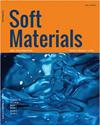抗氧化分子有助于水悬浮液中纳米颗粒的稳定
IF 1.4
4区 材料科学
Q4 MATERIALS SCIENCE, MULTIDISCIPLINARY
引用次数: 0
摘要
摘要研究了抗氧化涂层磁性纳米颗粒(MNPs)的制备,以提高其生物相容性,即减少负面副作用。理论研究的重点是没食子酸(GA)与离子铁在纳米颗粒表面的相互作用,这种相互作用增加了反应性,有利于磁性纳米颗粒在水中的均匀分散,以及与其他生物医学感兴趣的分子的相互作用。在实验上,我们研究了一种在80°C下用GA涂覆MNP的最佳方法,这导致TEM强调的精细颗粒化,XRD证明的良好结晶度的保持,以及基于磁性靶向引导的适用于生物医学应用的磁性。纳米毒性的研究集中在生物圈中被消除的MNPs的命运上,因此寻求个体发育早期对幼苗光合作用的影响。光合作用效率的微小变化(呈积极趋势)与毒性效应的平衡有关,即通过GA的抗氧化特性,铁离子从MNP表面催化产生ROS。本文章由计算机程序翻译,如有差异,请以英文原文为准。
Antioxidant molecule useful in the stabilization of nanoparticles in water suspension
ABSTRACT The preparation of antioxidant-coated magnetic nanoparticles (MNPs) has been studied to improve their biocompatibility, i.e. reducing negative side effects. The theoretical study was focused on the interaction of gallic acid (GA) with ionic iron at the surface of nanoparticles that increased reactivity and favors the uniform dispersion in water of magnetic nanoparticles and the interaction with other molecules of biomedical interest. Experimentally, we worked with an optimal method of coating the MNP with GA at 80°C which led to fine granulation highlighted by TEM, preservation of good crystallinity, proven by XRD as well as magnetic properties suitable for biomedical applications based on magnetically targeted guidance. The study of nanotoxicity was focused on the fate of MNPs eliminated in the biosphere, so the influence on photosynthesis in seedlings in early ontogenetic stages was sought. The small variation, with a positive trend, of the efficiency of photosynthesis was correlated with the balancing of the toxic effects, of ROS generation catalyzed by iron ions from the MNP surface by means of the antioxidant character of GA.
求助全文
通过发布文献求助,成功后即可免费获取论文全文。
去求助
来源期刊

Soft Materials
工程技术-材料科学:综合
CiteScore
2.90
自引率
0.00%
发文量
21
审稿时长
2.2 months
期刊介绍:
Providing a common forum for all soft matter scientists, Soft Materials covers theory, simulation, and experimental research in this rapidly expanding and interdisciplinary field. As soft materials are often at the heart of modern technologies, soft matter science has implications and applications in many areas ranging from biology to engineering.
Unlike many journals which focus primarily on individual classes of materials or particular applications, Soft Materials draw on all physical, chemical, materials science, and biological aspects of soft matter. Featured topics include polymers, biomacromolecules, colloids, membranes, Langmuir-Blodgett films, liquid crystals, granular matter, soft interfaces, complex fluids, surfactants, gels, nanomaterials, self-organization, supramolecular science, molecular recognition, soft glasses, amphiphiles, foams, and active matter.
Truly international in scope, Soft Materials contains original research, invited reviews, in-depth technical tutorials, and book reviews.
 求助内容:
求助内容: 应助结果提醒方式:
应助结果提醒方式:


